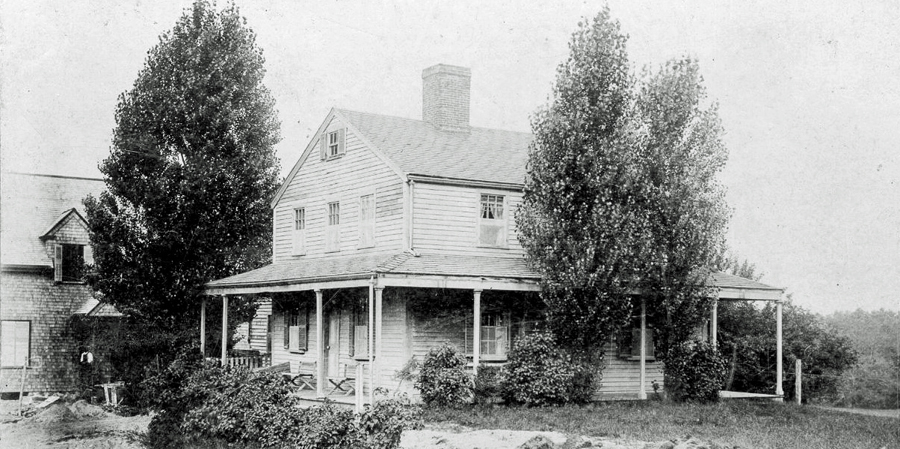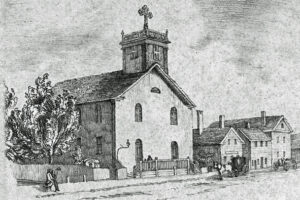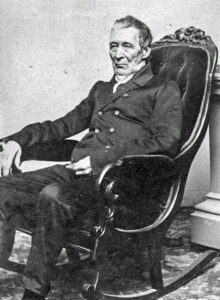True Tales from Canton’s Past: A Poisonous Marriage
By George T. Comeau
The Shaller House in Canton was built in 1744 and demolished in 1895 to make way for the Milton-Hoosic Golf Course. (Courtesy of the Canton Historical Society)
At the ripe age of 57, James Shaller looked out across his farm and gave pause. He was at a point in his life where he had attained considerable wealth, land holdings and a farm that was the envy of many of his neighbors in Canton. His house was comfortable and the woman’s touches that surrounded him were from the hands of his two sisters who lived with him. Laura and Rebecca Shaller had never married, and the three siblings lived on the farm that was located just off present-day Green Lodge Street. It was a good life, and yet James would not live past 59.
The Shaller land had been in the family since 1696. Originally known as Lot 4 of the Twelve Divisions, this was the land that had once been deeded to the Ponkapoag Tribe. Elizabeth Vose married Michael Shaller and Elizabeth’s father gave the large parcel of land to Michael. Not very much is known of the Shaller family prior to their arrival in Canton. Michael’s father was a Frenchman who traveled from Paris to Barbados to learn the process of distillation. The family business was carried on by Michael, who was called a “Stiller.”
The farm was prosperous and the Shallers raised rye and Indian corn — much of which was likely distilled into hard liquor. Two horses, eight cows and a pair of oxen rounded out the property nicely. By 1858 the property covered more than 200 acres valued at as much as $10,000. In addition, James Shaller also owned several acres of woodland and he would sell the seasoned wood to customers in Boston.
In December 1858, Shaller delivered a load of wood to Mrs. Patrick Russell in East Boston. Mrs. Russell asked why the middle-aged farmer had never married. Shaller replied, “I have not yet met a woman that suits me for a wife, and if I were to marry at all, I wish to marry a young woman.” To which Mrs. Russell replied, “I have two nieces and perhaps one would be suitable.” The pair of nieces were Adelaide and Catherine VanTassel. At the time, Adelaide was 16 and Catherine was 17. Mrs. Russell invited Shaller to a Christmas dinner and it seems that Shaller was hard pressed to choose one of the young ladies as a prospective wife. It was then decided that both Adelaide and Catherine visit the farm in Canton and Shaller would marry the young girl that seemed most pleased with the farm.
The VanTassel family were Loyalist Dutch colonists residing in New York City during the American Revolution. At the end of the war, Abraham VanTassel moved his family to Digby, Nova Scotia. In 1801, the family received a grant of 200 acres, which were still in the family several generations later. What will be most hard to believe is that Adelaide and Catherine were only two of 10 children, and their father had a total of 26 children across two marriages. Adelaide arrived in Boston at the age of 15 aboard the Schooner Operant from Digby and lived with relatives in the city.
On January 25, 1859, Shaller and VanTassel were married by Father Thomas Lynch at St. Patrick’s Church on Northampton Street in Boston. Shaller was quite pleased with Adelaide despite the more that 40-year age difference. Adelaide was described as being “possessed of considerable personal beauty.”
The couple lived in the Shaller house alongside Rebecca and Laura. According to many neighbors in Canton, however, the couple was living together unhappily. “The girl consoled herself with the hope of his death, and her ultimate possession of his property,” noted one observer. Soon, facts compromising the character of Adelaide were made public, revealing “improper intimacies between her and several young men,” including at least one who was employed on the farm.
The salaciousness of the “intimacies” were upon every lip in North Canton. Eyebrows were raised when Adelaide began a dalliance with a farmhand named Robert Davis. According to published reports, Adelaide’s conduct was “openly and unblushingly profligate, her husband being overawed and completely under her control.” The two lovers on one occasion traveled to Boston and stayed in a hotel overnight under the name of Mr. Harrison and “lady.” According to the story, Adelaide paid the hotel bill. When word reached Canton, the sisters were incensed. Within two months, Rebecca and Laura were “turned away from the family homestead.”
Laura Shaller went to live in Milton and Rebecca moved to Dedham. It was an eventful year for many reasons. In July, Adelaide was pregnant. Again, tongues wagged, for if the child was indeed James’s it would mean that Adelaide would “get control of the of the whole property, to the exclusion of the other relatives … who did not feel inclined to lose their patrimony in such a manner.” The question as to whether the child was her husband’s or perhaps a local farmhand’s spread like wildfire through the small town.
On September 21, 1859, Rebecca died of heart disease and was buried at Canton Corner. It is not known if James attended the funeral of his dear sister. For over a month, he had been complaining of stomach pains. Things progressed badly, and after 28 days of declining health, less than a week after the passing of his sister, James Shaller died. The marriage had lasted merely eight months and three days.
The cause of death was listed as typhoid fever, which includes symptoms such as weakness, stomach pain, headache, cough, and a loss of appetite. The gastrointestinal tract is more severely affected and the usual course can take as little as two or three weeks. Typhoid fever is highly contagious, and passes through fecal contamination of food and water. In 1859, 37 people died in Canton, and only one purportedly died of typhoid. At the time of Shaller’s death and burial there were “many rumors and suspicions in circulation in regard to foul play,” as citizens made mention of Adelaide’s “reckless course of life” and the “remarks which were attributed to her previous to his death.”
The Board of Selectmen at the time granted leave for the body to be exhumed. John D. Bradley of Milton, deputy sherriff and coroner, summoned a jury consisting of six prominent men from Canton. The body was removed from the grave and brought to Boston for examination. Dr. Frederick Smith Ainsworth, a highly regarded physician and the demonstrator of anatomy at Harvard Medical School, performed the autopsy. This was the doctor that had the deepest knowledge of poisoning and its effects on the body. A separate study of the main organs was done by Dr. James Jackson, the most prominent physician in Boston for over half a century. It was a powerhouse duo to be sure.
On a Thursday afternoon Deputy Sherriff Rufus C. Woods proceeded to the home of Adelaide Shaller and placed her under arrest for adultery. Adelaide was taken to the jail in Dedham to await her fate and the autopsy results. Bail was set at $2,000 and the coroner’s jury examined the body. Meanwhile, a large number of letters that Adelaide had written to her lover were furnished as proof of her crime. The coroner’s inquest found that Shaller died of lung disease; and while the results cleared Adelaide of murder, the sheriff pushed forward and she was found guilty of adultery.
On April 3, 1860, Adelaide gave birth to a baby girl and named her Mary Ann Shaller. In the spacious house, Adelaide was joined by her 19-year-old sister, Catherine, and her 17-year-old brother, Eben. On April 14, 1861, 18 months after the death of her first husband, Adelaide married 18-year-old John Curran, who was one year her junior. Twelve days later, baby Mary Ann died of the croup. In December 1861, James’s brother William moved to sell the family homestead. The land on both sides of Green and Green Lodge streets were sold for $8,600.
Curran, a bootmaker, would join the Union Army and fight in the Civil War. Returning home, the family lived in Brookline and had a son in 1863. In 1891, Adelaide Curran died of pulmonary tuberculosis in Boston. John Curran died in 1912 at the Togus Soldiers’ Home in Kennebec, Maine, and is buried in St. Mary’s Cemetery. It is not known where Adelaide or James are buried. Much of the Shaller land is today the Milton-Hoosic Club and the Bradley Estate.
Short URL: https://www.thecantoncitizen.com/?p=87464












